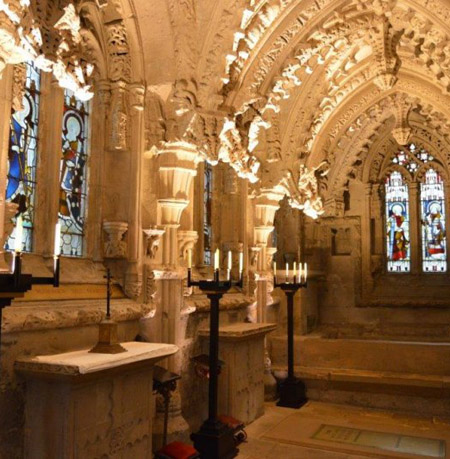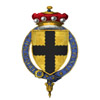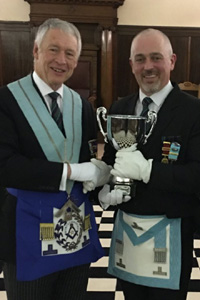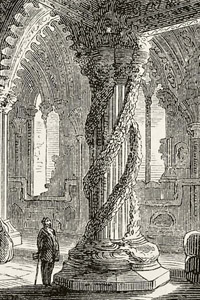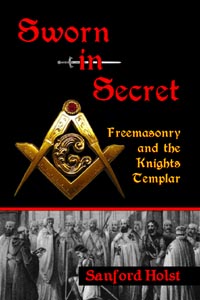|
rosslyn chapel and freemasonry |
||
|
|
||
|
|
Rosslyn Chapel and Freemasonry
This lecture on Rosslyn Chapel and Freemasonry won the 2018 lecture competition sponsored by the Provincial Grand Lodge of Worcestershire. It was written by David Wilson, Past Master of Northfield Lodge No. 5056 in Worcestershire.
I
have always found quite fascinating the subject of the origins of
Freemasonry, which until recently I had never heard adequately explained. The
theory that stonemasons in Scotland had formed an underground and secret
society, with its own passwords and ceremonies seemed improbable, as there
was simply no reason for them to go to such lengths to conceal their craft.
The fact that these ceremonies were all based around the Temple of Solomon
in Jerusalem (which likely none of them had ever visited) reinforced my view
that there must be some better explanation. As
the Knights Templar were the only group (even to this day) to have excavated
the Temple of Solomon, it always put at the back of my mind the fact that
they could be a link between the Order and the genesis of Freemasonry. The
need for secrecy, to avoid being burned as a heretic, would have been a
strong motivation for going underground. Reading
Sanford Holst’s book “Sworn in Secret” last year, and to a lesser
extent “Born in Blood” by John Robinson convinced me that this was
indeed the case, and that the argument that has raged since Chevalier
Ramsey’s emotive Templar claim in 1739 was now effectively settled. The
fall of the Templars was indeed the birth of Freemasonry. Both
the Regius Manuscript and the Cooke Manuscript show that Freemasonry was
alive and well as far back as 1390. Records from the Peasants Revolt in 1381
show that a “Great Society” was clearly in existence then, and this was
verified by numerous independent sources. Realistically,
that “Great Society” could only have been the Freemasons. From
the fall of the Templars in 1312 to the Peasants Revolt in 1381 is not a
great leap in terms of time, and one that was clearly evidenced by Sanford
Holst. I
could go into all of the evidence that has been recently uncovered and
documented by Mr Holst, but that is not my purpose. It is sufficient for me
to say that I found the case for the Templar links overwhelming, and the
Regius Manuscript and the Cooke Manuscript were hugely interesting documents
in themselves. Although
they were quite lengthy, I made sure I read them in their entirety so as to
fully understand them, rather than relying solely on the interpretations of
others. The Cooke Manuscript especially, is very clear in the way it
identified Freemasonry within its text, but both are obviously Masonic
documents, and widely accepted as such. The
Regius Document is a little different, and contains information which I will
come back to later. Rosslyn Chapel The
acceptance of the Templar version of events drew me back to Rosslyn Chapel,
that beautiful building close to Edinburgh that has been linked to both the
Freemasons and the Templars by Hollywood, writers, and theorists alike. Many
of the suggested links have been works of fiction, or wishful thinking.
There is no evidence to suggest that a Templar force came to the aid of
Robert the Bruce at Bannockburn in 1314. Hugh de Payens (First Grand Master
of the Knights Templar) was not married to Catherine Sinclair, daughter of
the Earl of Rosslyn, despite claims as to this on numerous Templar websites. But
there are facts which do support Templar/Masonic links, they have just been
a little harder to find. The
fact that the Earls of Rosslyn were shown to be the hereditary Grand Masters
of Scottish Freemasonry prior to
the official formation in 1736 was a crystal clear indication of the
Chapel’s links to Freemasonry. Hugh
de Payens, the first Grand Master of the Knights Templar, fought with Henry Sinclair (2nd Baron of Rosslyn) in the first
Crusade, and visited Scotland in 1128. He sought grants of land to support
the Order, and the first grant of land given to the Templars in the UK was
less than four miles away from Rosslyn. The links to the Templars were there
also. The design of Rosslyn Chapel itself has been
the subject of much debate, and there is clearly something very different
about it. In an age where the Church burned heretics on a regular basis,
here was a religious building that held little or no Christian imagery, as
well as objects that were certainly not Christian at all. So why was it designed this way, and why were
there so many Pagan and obscure images contained in it? If the Sinclair family were linked to both
the Templars and the Freemasons, it would likely be evident in the design. There was one particular piece of the Chapel
I had always found rather odd, and that was the four altars on the east wall
of the Lady Chapel. We are told in the “official” version of
the design that the Sinclair family designed it this way so that four
priests could pray around the clock (six hours per day each) for the souls
of the Sinclair ancestors. One altar for each priest. Why four? What had the Sinclair’s ancestors done to
need such prayer or atonement? Furthermore they are oddly arranged, in that
one of them is slightly higher than the other three. We are told that this was to accommodate the
stairway leading down to an older part of the building that predated Rosslyn
Chapel, but that makes no sense. The other three altars could just have been
raised slightly to show in line with the higher one, and the symmetry of the
building maintained. As with everything at Rosslyn, I have never
believed that it was random or in error. This beautifully designed structure
has a reason behind every brick of it, even if we don’t fully understand
what those reasons are. Having dated the origins of Freemasonry to
before the date that the Chapel was built, both the Templars and Freemasonry
could have influenced its design. The question was: could it be evidenced? Was there anything significant enough in
Templar history or symbolism that stood out to the point that it would
likely be incorporated in some way? Going
back to the history of the Templars, and their dissolution of the Order in
1312, which is probably the most significant piece of Templar history, I
read in depth about the trials of many of the knights. And then I came across the line which gave me
a moment of inspiration. Four of the Templars had been tried
separately, and last. They were Jacques de Molay (Grand Master of the Order), Geoffrey
de Charney (Grand Commander of Normandy), Geoffrey of Goneville (Grand
Commander of Aquitaine, & Poitou), & Hugh Peraud (Grand Commander of
the Isle de France). A
Grand Master, and three Provincial Grand Masters. Three on a level together,
and one slightly higher. Could
these four Templars be the inspiration behind the four altars at the Lady
Chapel? What
other similarities or links were there between these four and the four
altars at Rosslyn? Even
though they were innocent, could the fact that they were convicted and
sentenced as heretics lead the descendants of their organisation to have
prayers for the delivery of their souls said for them every hour of the day? Four Crowned Ones This
possibility immediately made me think of a passage in the Regius Document,
which talks about the “Four Crowned
Ones”. The document describes them as the “Holy
Martyrs Fours”, who “would not
give up their true faith”. There is also a reference of an Emperor
ordering them to make false idols. It refers to them as being “Put in a deep prison” by an Emperor who “sorely he punished them in that place”,
and then put them to death. That
description matched exactly the last days of the four Templars, who were put
in prison by King Philip IV of France and initially confessed to heresy
(under torture) and the worship of false idols. When
the four were sentenced together, Jacques de Molay & Geoffrey de Charney
recanted their confessions and were burned at the stake the same day, but
all four died at the hands of the King of France. A
very good reason for their souls to be prayed for every hour of the day. I
include the relevant passage from the Regius Document rather than simply
quoting from it. The
art of the four
crowned ones. Pray
we now to God almight, (almighty) That
we may keep these articles here, But
they were steadfast in Christ’s lay, (law) And
believe on his false lay, (law) There
are so many similarities between the “Four Crowned Ones”, and the four
Templar Masters, that it can be strongly inferred that the passage reads
about them. The
four together, who were put in prison and tortured although their faith was
true. The mention of false idols ,and their death of the four at the hands
of a false ruler. Relating
that to the four altars at Rosslyn, there are three on a level, and one
slightly higher. I fully believe, that all these similarities (especially
when we can already link the Templars to the birth of Freemasonry) were no
coincidence. If
this is indeed the case, and the four altars represent both the four senior
Templars and the Four Crowned Ones (and thereby identify them as one and the
same), then it not only makes another direct link between the Templars and
Freemasonry via the Regius
document, but also between both those entities and design of Rosslyn Chapel.
As
an ex-Police Intelligence Inspector, I have use the word “inferred” in
its proper context. The Oxford Dictionary defines the word “infer” as
“Deduce or conclude (something) from
evidence and reasoning rather than from explicit statements”. So
while the links outlined are not explicitly stated (and the realities of
life in 1390 meant that it was never going to be), I believe that they are
very reasonable conclusions to draw from the available evidence. As
ever, such theories will be the subject of much debate, and I look forward
to hearing from anyone who wishes to contribute further on the subject.
Rosslyn Chapel and Freemasonry ____________Masonic Articles in this Site____________ Rare Masonic books, Civil War, Best Masonic books, Masonic directory, Masons Templars, Masonic research Masonic authors, Civil War2, Templar medals, Table Lodge Buffalo Bill Cody, Quarry Project, Old Time Freemasonry Sworn in Secret, Early American, Knights Templar, Civil War3 Latest books, Born in Blood, Solomon's Temple, Coil's Encyclopedia York Rite, Allen Roberts, John Robinson, 2010 symposium, Allen Price Grand Lodge England, Holy Grail, Kabbalah, Nadia, Robert Burns Masonic education, UCLA, Stonemasons, Scottish Lodge US Lodges, UK Lodges, Canada Lodges, Australia Lodges Templar Swords, Freemason, Templar Trials, Templars Vatican Origin of Freemasonry, Templar history, Freemasons history © 2008-2024 Sanford Holst - web design by webwizards |
Provincial Grand Master Robert Vaughan presents lecture trophy to PM David Wilson
Rosslyn Chapel Apprentice Pillar stands in front of the four altars Rosslyn Chapel and Freemasonry |







